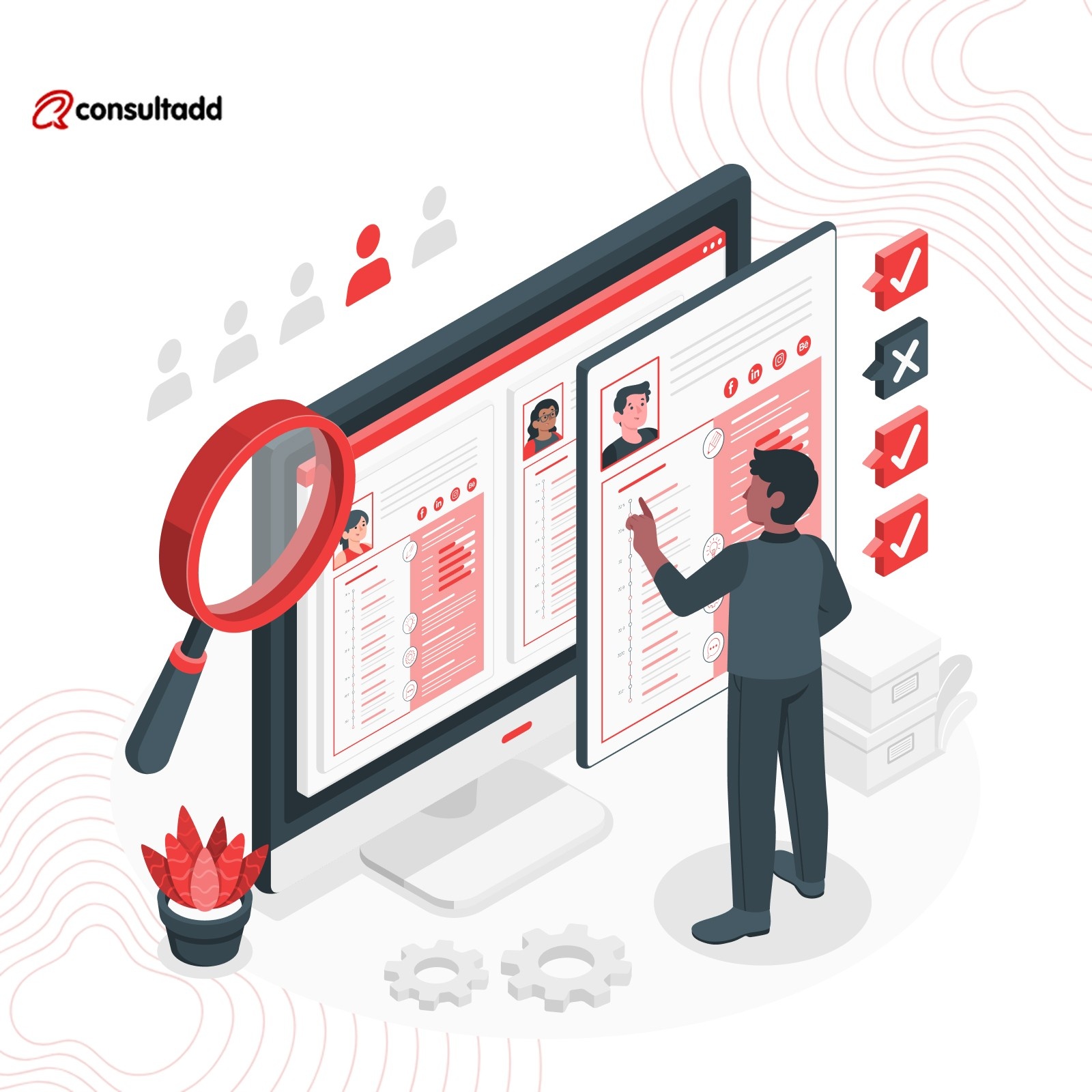You’re expected to deliver qualified candidates quickly but the right ones are getting harder to find.
You reach out, follow up, wait… only to realize the skills just aren’t there. Or worse, they’re close but not close enough.
It’s not just you. Around 74% of employers worldwide are already feeling the pressure of skills shortages. And in 2025, that pressure is only growing.
The skills gap isn’t about missing resumes, it’s about missing capabilities. Roles are evolving faster than talent can catch up, and staffing agencies are left holding the gap.
But here’s the upside: understanding where those gaps exist and how to close them is the first step to delivering real value to your clients.
In this blog, we’ll understand what the skills gap really means in 2025, why it’s become mission-critical, and how you can stay ahead of it.
TL;DR
- Skills gaps are widening fast: AI, automation, and evolving tech outpace traditional hiring and training models.
- Hiring for roles won’t cut it: You need to hire for capabilities, not resumes or degrees.
- Strategic actions win: Upskilling, internal mobility, and skill-first hiring are now competitive advantages.
- Consultadd delivers future-ready talent: With vetted candidates, 24-hour sourcing, and post-hire support, we help you close gaps before they cost you.
Understanding the Skills Gap in 2025
You’re moving fast, reviewing profiles, setting up interviews, managing client expectations.
But what happens when the talent you find can’t do the work your client needs?
What Is a Skills Gap?
A skills gap is the mismatch between an employee’s current capabilities and the skills required to succeed in a role now or in the future.
The Nature and Types of Skills Gaps in 2025
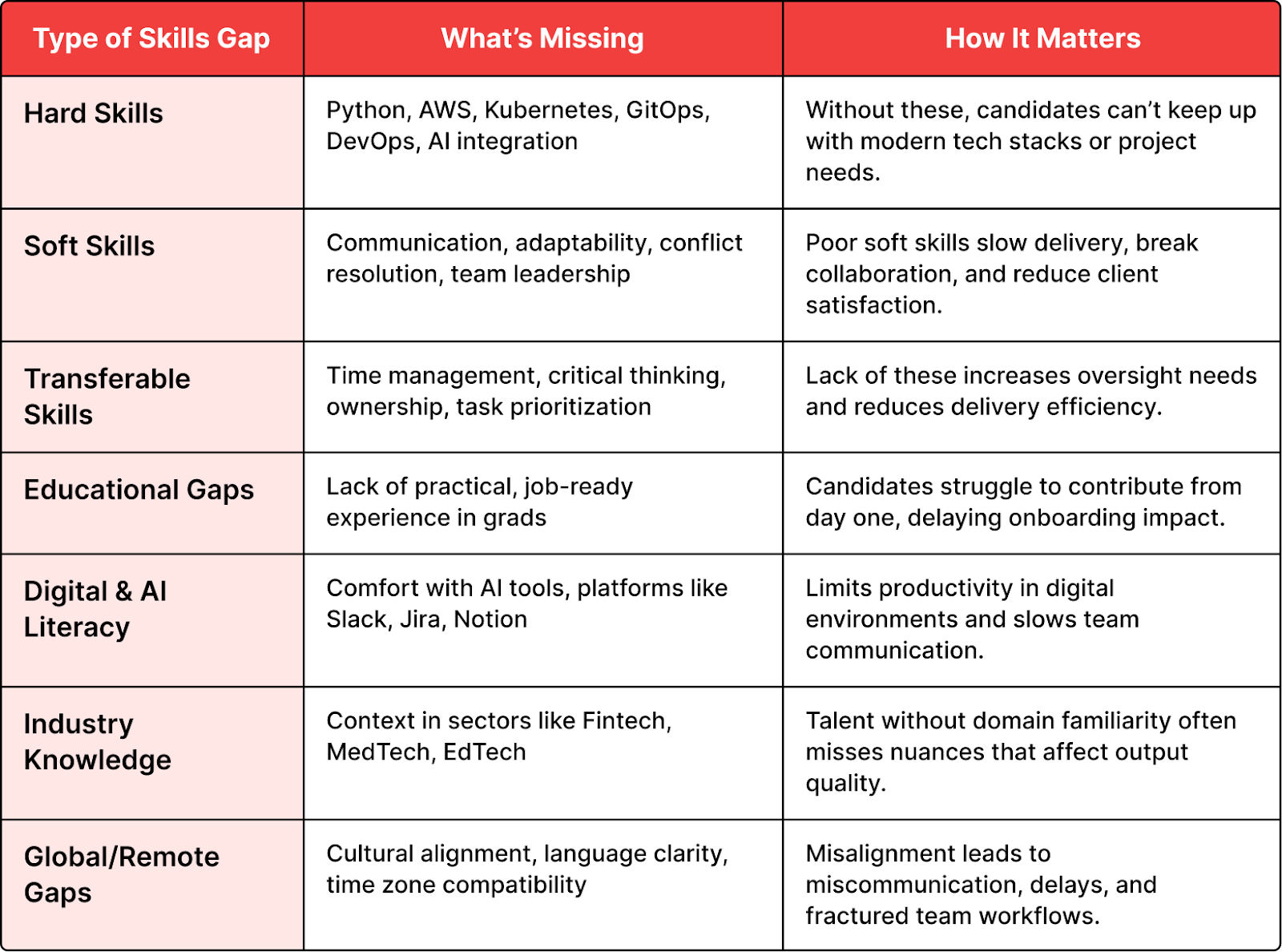
In 2025, skills gaps reflect missing real-world readiness, spanning various types.
Causes of the Skills Gap Today
1. Tech Disruption
AI, automation, and cloud technologies are advancing at breakneck speed.
Most teams can’t train fast enough to keep up with evolving tools and platforms.
2. Job Fragmentation
Roles are no longer siloed, one DevOps engineer may need to code, secure, and deploy.
This blend of responsibilities creates unrealistic expectations for a single hire.
3. Outdated Education
Many institutions still focus on theory and outdated tools.
Graduates often enter the workforce lacking job-ready, hands-on experience.
4. Static HR Practices
Relying on degrees, resumes, or job titles overlooks practical skill and growth potential.
Traditional hiring methods miss hidden talent and limit diversity in skill sets.
5. Limited Upskilling
Internal upskilling is often reactive, not planned.
Top performers are frequently sourced externally instead of being developed from within.
Why Closing the Skills Gap Is Mission-Critical
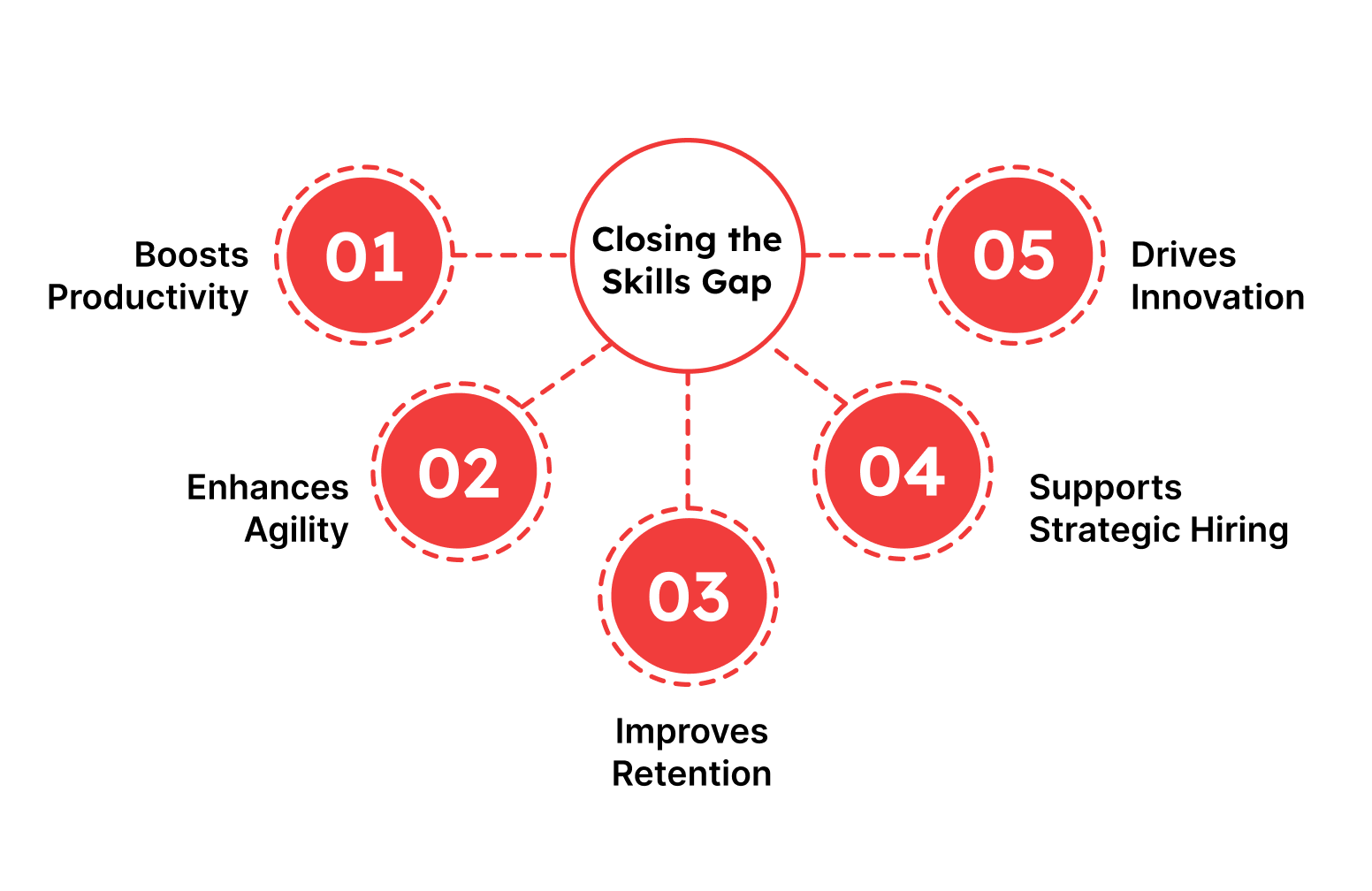
Closing the skills gap isn’t just a talent issue, it’s a business imperative.
- Boosts Productivity
Skilled talent doesn’t just complete tasks; they do it faster, smarter, and with fewer errors.
This means less hand-holding, quicker turnarounds, and more trust from clients. - Enhances Agility
Teams with up-to-date skills can shift gears with changing tech or project needs.
This flexibility helps you meet evolving client demands without missing a beat. - Improves Retention
Employees who are trained and growing are more likely to stay and deliver long-term value.
Upskilling shows investment, which builds loyalty and reduces costly turnover. - Supports Strategic Hiring
It’s not just about speed, it’s about accuracy.
Identifying and filling actual skill gaps helps you match the right candidate to the right role. - Drives Innovation
Fresh skills spark fresh thinking.
When teams are equipped with current knowledge, they bring ideas that keep clients ahead of the curve.
How to Identify Skills Gaps in 2025
You can’t fill what you can’t see.
And in 2025, invisible skill gaps cost time, trust, and revenue.
Therefore, spotting these gaps early helps you pitch stronger candidates, build client confidence, and reduce rework.
1. Conduct a Skills Gap Analysis
If hiring feels like a guessing game, you’re not alone.
Placing great candidates starts with knowing exactly what’s missing and where.
A skills gap analysis eliminates the guesswork.
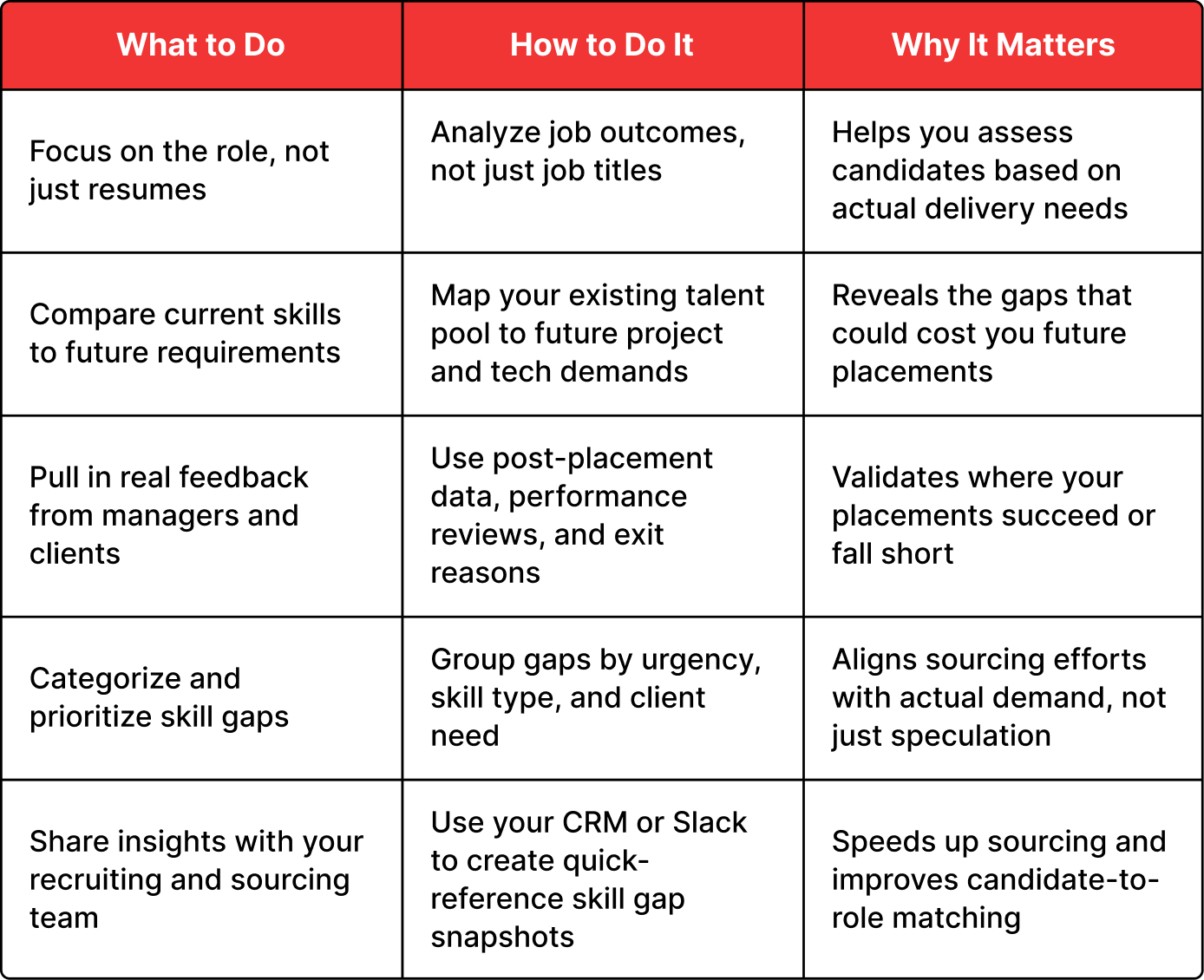
2. Use Feedback Mechanisms

Instinct isn’t enough when hiring is on the line.
Feedback gives you the clarity that resumes and interviews often miss.
- Post-Placement Feedback Loops
Ask hiring managers what worked and what didn’t after 30, 60, or 90 days.
Spot recurring skill issues in real-world delivery. - 360° Reviews with Candidates
Let candidates self-evaluate, then compare it with peer and manager input.
This reveals blind spots and overestimated strengths. - Quick Hiring Team Surveys
Use 3–5 focused questions after every hire.
Track consistent themes around preparedness, skill gaps, and fit. - Build a Feedback Bank
Capture input across roles, teams, and placements in one place.
Use it to adjust sourcing, prep, and placement decisions faster.
3. Maintain Skills Inventories
When speed matters, guesswork costs you.
An up-to-date skills inventory helps you pitch faster, fill smarter, and stay one step ahead.
Keep a live record of skills so you don’t start from scratch with each new requirement.
Here’s what your inventory should capture:
- Verified hard skills
- Soft skills and team traits
- Industry exposure
- Certifications and tooling
- Availability and work status
Update these regularly, post-interview, after client feedback, or once new training is complete.
Proven Ways to Address Skills Gaps in 2025
You’ve identified the gap, now what?
The right moves today can help you meet client demands before they even ask. It’s not just about patching holes. It’s about building a bench of talent that’s future-ready.

Jason Wingard, former President of Temple University, said:
“Successfully navigating complex change requires the ability to lead people through uncertainty.”
During his leadership, he pushed institutions to align learning with real-world needs, something staffing leaders must do too.
1. Develop Internal Talent with Personalized Learning
When the right talent is hard to find, build it.
Your bench could be stronger than you think.
What this looks like in action:
- AI-curated learning paths
Recommend training based on role, project, or client stack. - Access to top learning platforms
Think: LinkedIn Learning, Coursera, Udemy, not generic webinars. - Mentorship and job shadowing
Real-world exposure builds confidence and clarity. - Cross-functional projects
Let engineers try DevOps, or QA folks explore automation. - Micro-certifications
Quick wins in tools like AWS, Kubernetes, or GitHub Actions.
When learning feels relevant, talent sticks and grows.
2. Implement Dynamic Workforce and Succession Planning
Workforce plans can’t live in spreadsheets anymore because the client needs tend to shift overnight.
What’s missing today isn’t just people. It’s people with the right skills, at the right time.
The fix? Build a system that constantly asks: “What roles will matter 6 months from now?”
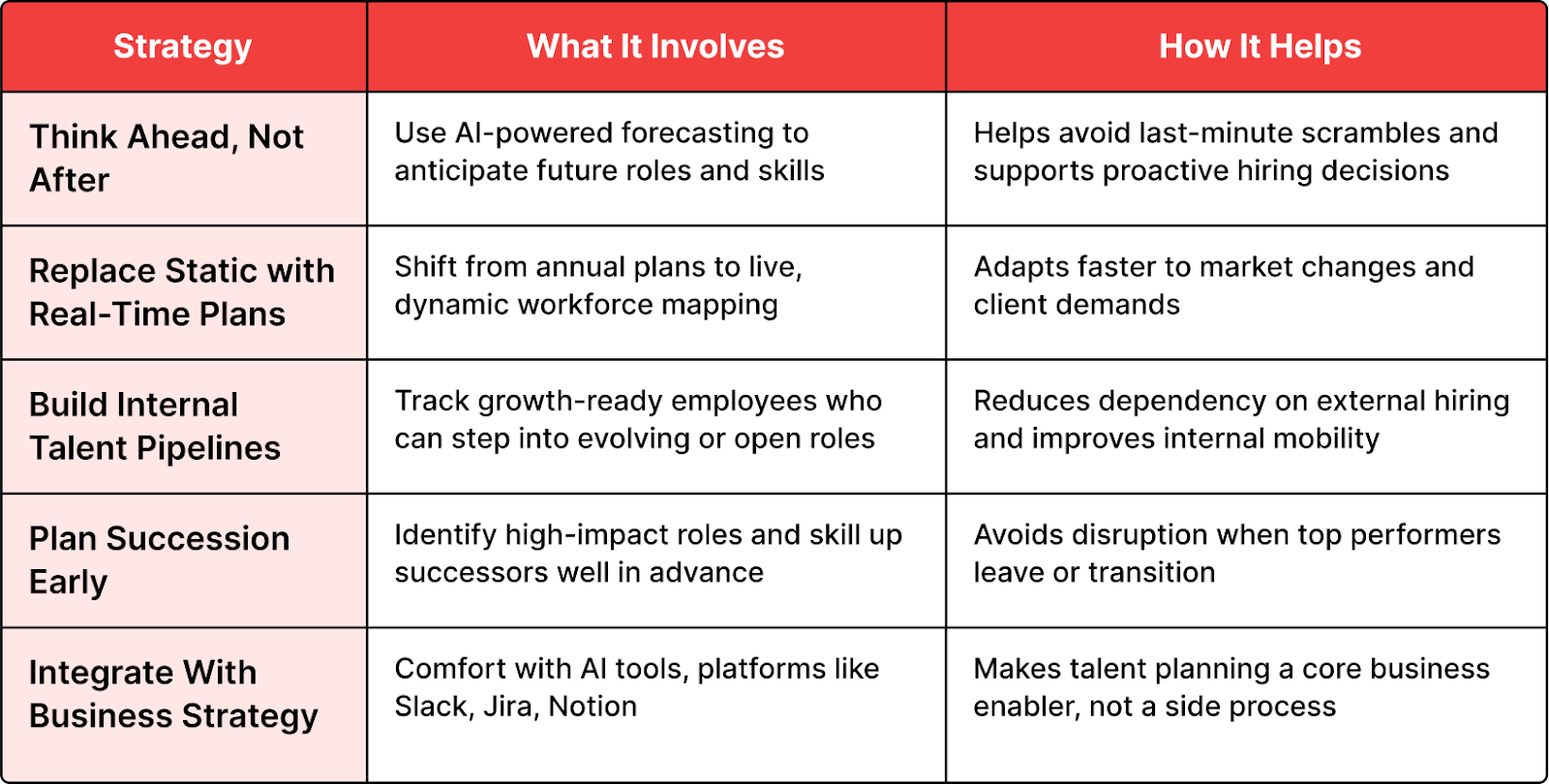
3. Embrace Skills-Based Hiring
a. Still filtering candidates by job titles and degrees?
That’s like judging a book by its publisher. Some of the best tech talent doesn’t come from traditional routes, they come with real skills, proven projects, and the grit to deliver.
b. What if you hired based on what candidates can do, not just what’s on paper?
Skills-based hiring puts capability front and center. Think task-first, test-first, and title-last.
c. Are your job descriptions filtering out great talent?
Revamp your listings to focus on deliverables, not credentials. A DevOps pro doesn’t need a four-year degree to build reliable pipelines.
d. How can you actually assess skills?
Skip generic interviews. Instead, try real-world challenges:
- Code tests
- Portfolio reviews
- Simulated tasks
- Paid pilot projects
e. Where can you find skill-rich, title-light candidates?
Look beyond the resume stack. Consider:
- Bootcamp grads
- Career switchers
- Freelancers and gig workers
- Community contributors (e.g., GitHub, open source)
When you hire for skill over status, you get candidates who perform, not just impress on paper.
Learn more about skills-based hiring in our blog: “Most Wanted Skills You Should Know in Skills‑Based Hiring”.
4. Strategic Partnerships & Industry Engagement
When the market moves fast, strong partnerships gives you early access to talent, insights, and demand before competitors catch on.
Why It Matters
- You can’t predict everything, but you can align with those shaping the future.
- Talent trends evolve quickly. Being inside the loop beats reacting from the outside.
What Strategic Partnerships Can Look Like
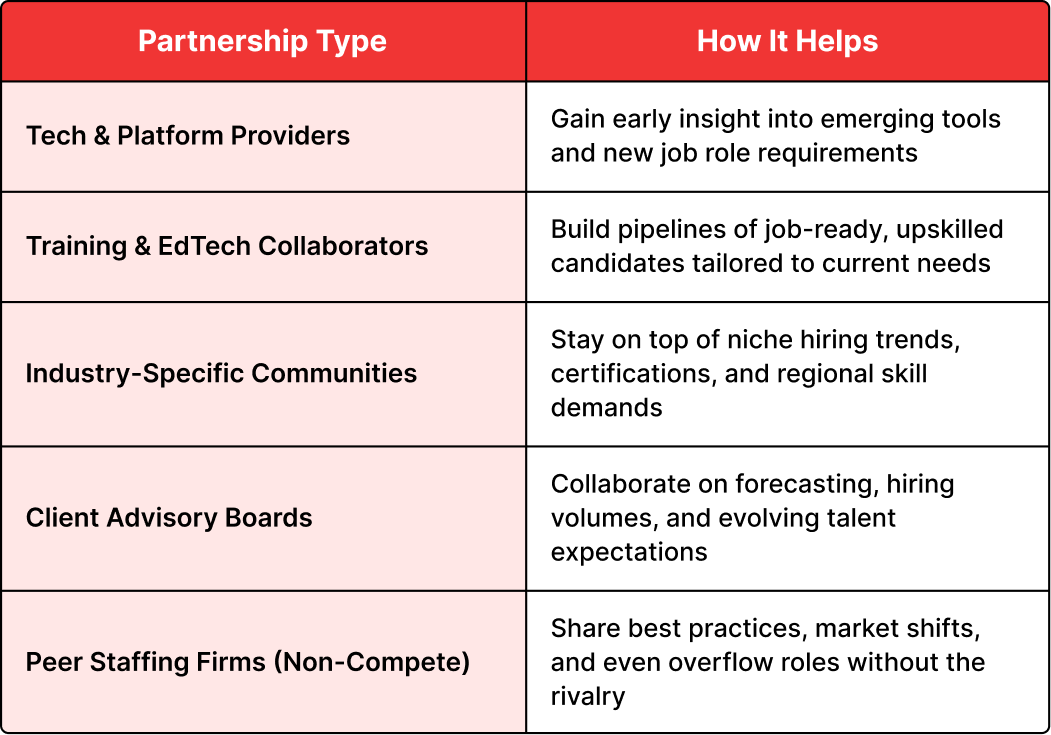
Pro Tip: Don’t wait for clients to tell you what they need, co-create the roadmap with them.
Remember, when partnerships are strategic, not transactional, you don’t just place talent, you shape the future of hiring.
5. Promote Internal Mobility and Cross-Functional Movement
Hiring externally isn’t always the fastest or the smartest answer. Sometimes, the perfect candidate is already inside the building. They just need the right push, plan, and platform.
- Build a Transparent Talent Marketplace
Let employees explore internal roles and express interest without stigma. - Create Cross-Training Opportunities
Rotate high performers into new teams for short-term projects or problem-solving sprints. - Recognize Transferable Skills
Don’t wait for an exact match, identify adjacent skills that fit the new role. - Support with Mentors and Microlearning
Guide transitions with short, focused training and peer support. - Reward Career Mobility
Celebrate lateral and vertical moves alike. Growth isn’t always about climbing.
6. Monitor Market Trends and Anticipate Emerging Skills
You can’t hire for tomorrow with yesterday’s job descriptions. Staying ahead means spotting skill shifts before others do.
Instead of reacting to change, lead it.
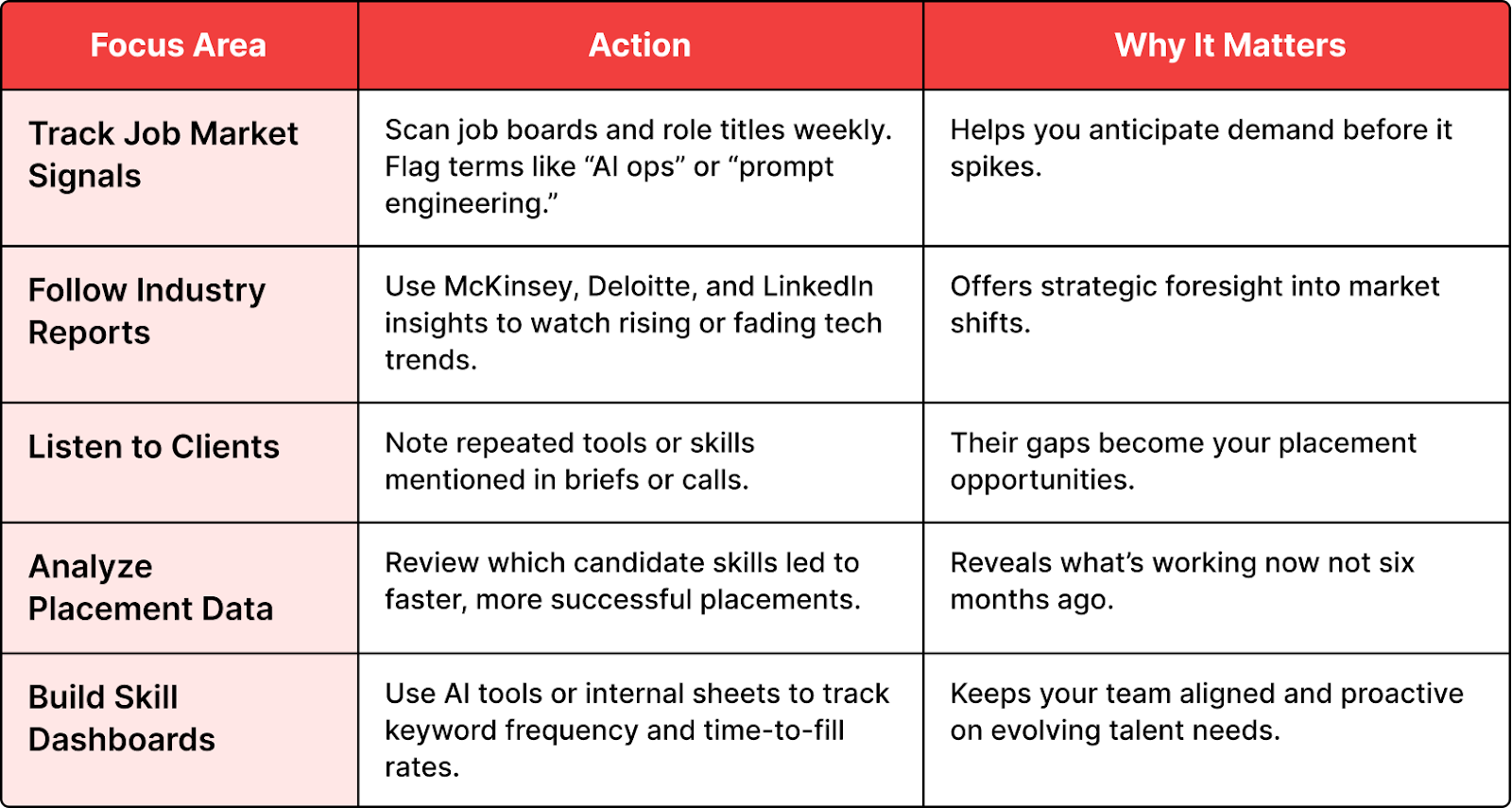
These proven ways become even more effective with Consultadd, as we deliver pre-vetted, ready-to-hire candidates with the exact skills clients need, fast and at scale.
Technological Enablers Closing Skills Gaps
Smart tech is reshaping how staffing firms detect and close talent gaps quickly, precisely, and at scale.
Here’s how top recruiters are gaining an edge:
1. AI-Powered Skill Mapping
Quickly links resumes to in-demand skills using real-time data.
Helps uncover qualified candidates others overlook.
2. Predictive Analytics
Forecasts upcoming skill demands based on hiring trends.
Let's you prep before the market feels the pressure.
3. Adaptive Learning Platforms
Offers up-to-date courses aligned with emerging tech roles.
Enables candidates to stay job-ready and relevant.
4. Talent Intelligence Systems
Combines market insights and performance data to guide hiring.
Improves placement speed and strategic fit.
Smart tech is reshaping how staffing firms detect and close talent gaps quickly, precisely, and at scale. For a strategic overview, check out our blog: “Creating a Strategic Talent Management Framework for 2025”.
Addressing Skills Gap Challenges with Future-Proof Solutions
Skills gaps are no longer a future problem, they’re today’s bottleneck. Solving them demands smarter systems, not just faster hiring.
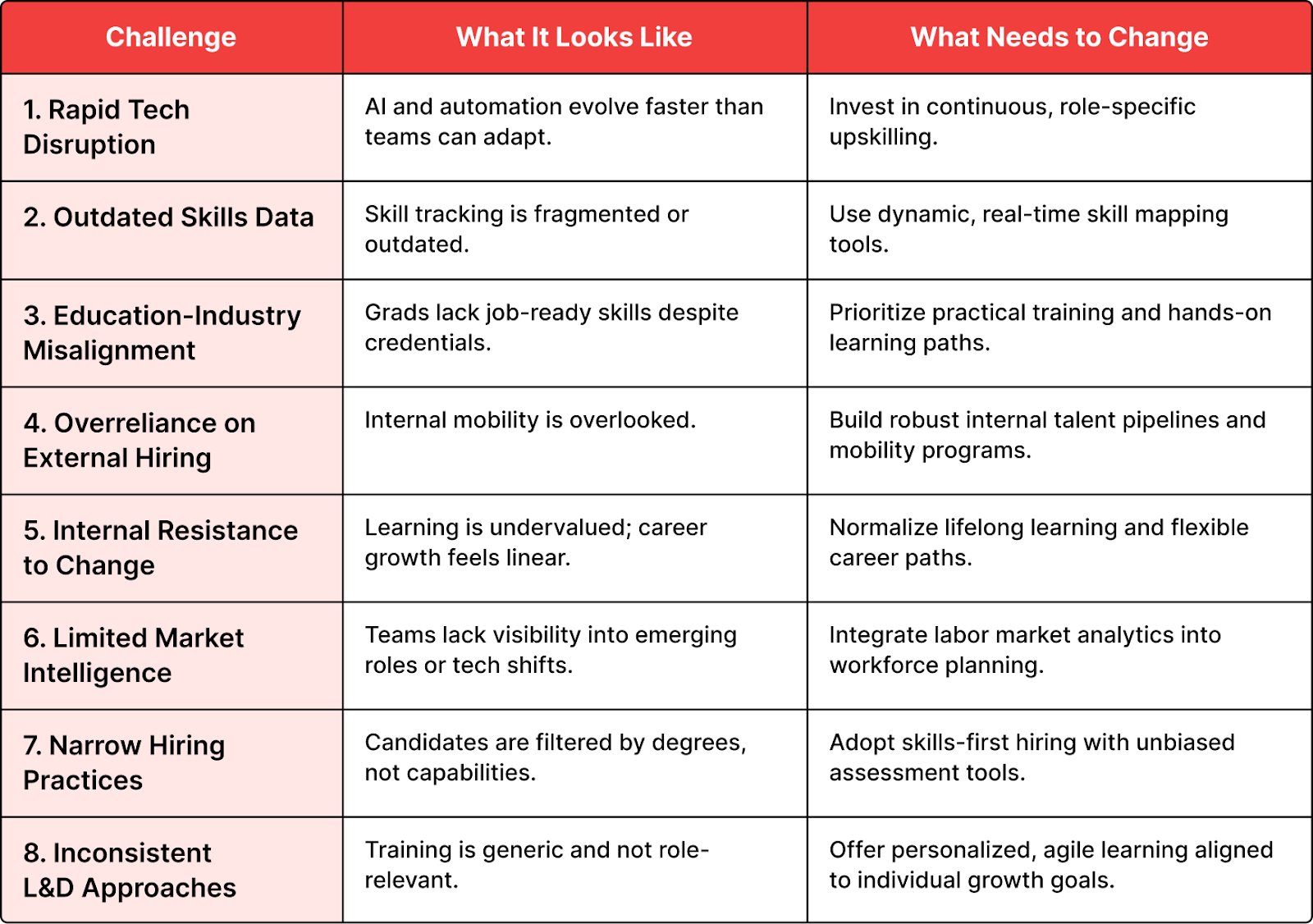
Consultadd uses deep domain expertise to match talent quickly and accurately. From compliance to engagement, every candidate is screened to reduce risk and hiring delays.
Conclusion: Bridging Skills Gaps Is the Blueprint for Long-Term Success
Skills gaps aren’t just a talent problem, they’re a growth blocker. Staffing agencies that act now, with speed and strategy, will become the true drivers of innovation.
That’s where Consultadd becomes your true partner in transformation.
With 14+ years of experience and 5,000+ successful staffing engagements, we’ve seen the market shift and we’ve helped our clients stay ahead of it.
Our 1:1 account managers don’t just fill roles; they help you build pipelines.
From top 100 candidates placed last year to MSAs with leaders like Robert Half and Teksystems, we know how to deliver high-impact results at scale.
Expect more than placements:
- Safe, reliable hires, thoroughly vetted for compliance and skill
- Ready-to-deploy talent, sourced in less than 24 hours
- Lower attrition, thanks to deep commitment and cultural alignment
- Seamless compliance, including visa support and documentation
- Ongoing support, so hires continue to thrive post-placement
- Backed by strong university ties and trusted by 65+ staffing partners annually
The skills gap isn’t going away. But with Consultadd, neither is your competitive edge.
Get in touch and let’s build the future of staffing together.
FAQs
1. What are the skills gaps in 2025?
Skills gaps in 2025 include deficits in AI, cloud computing, cybersecurity, digital literacy, and soft skills like adaptability. Roles are evolving faster than talent can keep up, leaving critical capabilities unfilled.
2. How to address the skills gap?
Address skills gaps by investing in upskilling, using skills-based hiring, enabling internal mobility, and leveraging tech-driven talent mapping. Proactive planning and continuous learning help build future-ready teams.
3. What is skills gap understanding?
It means identifying the mismatch between current employee capabilities and the skills required for present or future roles. This understanding enables targeted development and better hiring decisions.
4. What are the biggest skill gaps?
The largest gaps are in AI/ML, cybersecurity, cloud-native tools, digital communication, and leadership. Employers also struggle to find candidates with critical thinking, collaboration, and real-world problem-solving abilities.
5. What is the skills gap model?
The skills gap model compares existing workforce skills to those needed for optimal performance. It helps organizations pinpoint shortages, prioritize learning efforts, and align talent strategy with business goals.
6. What is the skills gap in technology?
Technology skill gaps refer to a lack of expertise in areas like AI, DevOps, cloud platforms, and cybersecurity. As digital tools evolve, many workers lack the training to keep pace.

